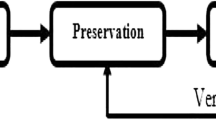Abstract
Cloud forensics is a product which has evolved with the combination of digital and computer forensics. Digital evidences involved in digital crime play an important role, and when this digital crime is carried out in cloud, then it is called as cloud crime. In a crime scene where it is important to isolate the entire scenario from the surroundings in order to collect the exact data at the time of crime, but the same is a little bit difficult and a challenging task to recover the information from a cloud crime, because here the investigator is connected to various cloud resources which may or may not be under his control and this may sometime lead against the privacy issues of cloud users. In this technological era where technology is changing the lifestyles of people, trends in various sectors either related to business, education, engineering, medical, scientific, and many other such kind of areas, with this vast growth of cloud in various areas, have opened a door for the intruders to carry out their mischief tasks, which may lead to various challenges regarding data breaches various other ways which lead to the disturbance of data or resources in the cloud. In digital forensics, it is evident to collect the information from a scene where Cloud forensics is a strategic solution to all such kind of things, where it is important to prove that how the disturbance or mischief task was carried out with a proof. Cloud computing is a boon for small-scale industries, with exponential growth of technology and the resources being required for the establishment of small-scale industries, and being very cost-effective which they are not affordable for such cases, cloud computing provides the resources to these industries so that they can even withstand the tough competition among themselves as well as from the big established companies. These things made the popularity of Cloud along with efficient and effective computing paradigm made cloud computing a popular thing.
Access this chapter
Tax calculation will be finalised at checkout
Purchases are for personal use only
Similar content being viewed by others
References
Ting, Y.-H., et al.: Design and implementation of a cloud digital forensic laboratory. In: Symposium on Cryptography and Information Security (2013)
Roussev, V., Ahmed, I., Barreto, A., McCulley, S., Shanmughan, V.: Cloud forensics–tool development studies and future outlook. Digital Investig. 18, 79–95 (2016)
Amazon Elastic Computing Cloud. aws.amazon.com/ec2
Cloud Hosting: CLoud Computing and Hybrid Infrastructure from GoGrid. http://www.gogrid.com
Google App Engine. http://code.google.com/appengine
Salesforce CRM. http://www.salesforce.com/platform
Dedicated Server, Managed Hosting, Web Hosting by Rackspace Hosting. http://www.rackspace.com
Mishra, A.K., et al.: Cloud forensics: state-of-the-art and reasearch challenges. In: International Symposium on Cloud and Services Computing (2012)
Mohiddin, S.K., Yalavarthi, S.B., Sharmila, S.: A complete ontological survey of cloud forensic in the area of cloud computing. In: Deep, K., et al. (eds.) Proceedings of Sixth International Conference on Soft Computing for Problem Solving. Advances in Intelligent Systems and Computing, vol. 547. Springer, Singapore (2017)
Microsoft: NW3C-Microsoft COFEE (2014). https://cofee.nw3c.org
Mitrokotsa, A., et al.: Intrusion detection in MANET using classification algorithms: the effects of cost and model selection. Ad Hoc Netw. 11(1), 226–237 (2013). ISSN: 15708705. https://doi.org/10.1013/j.adhoc.2012.05.006
Volatility: Volatility Introduction—volatility—Introduction to volatility—An advanced memory forensics framework (2014)
Slay, J., et al.: Advances in Digital Forensics V, Volume 306 of IFIP Advances in Information and Communication Technology, pp. 37–47. Springer, Berlin, Heidelberg (2009)
Craiger, P., et al.: Advances in Digital Forensics IV, Volume 285 of IFIP the International Federation for Information Processia. Springer, US (2008)
Al Fahdi, M., et al.: Challenges of digital forensic—a survey of researchers and practitioners attitudes and opinions. In: Information Security for South Africa, pp. 1–8. IEEE (Aug 2013)
Henry, P., et al.: The SANS survey of digital forensics and incident response. Technical report, SANS (July 2013)
https://resources.infosecinstitute.com/computer-forensics-tools
Author information
Authors and Affiliations
Corresponding author
Editor information
Editors and Affiliations
Rights and permissions
Copyright information
© 2019 Springer Nature Singapore Pte Ltd.
About this paper
Cite this paper
Khaja Mohiddin, S., Yalavarthi, S.B., Kondragunta, V. (2019). An Analytical Comparative Approach of Cloud Forensic Tools During Cyber Attacks in Cloud. In: Bansal, J., Das, K., Nagar, A., Deep, K., Ojha, A. (eds) Soft Computing for Problem Solving. Advances in Intelligent Systems and Computing, vol 817. Springer, Singapore. https://doi.org/10.1007/978-981-13-1595-4_41
Download citation
DOI: https://doi.org/10.1007/978-981-13-1595-4_41
Published:
Publisher Name: Springer, Singapore
Print ISBN: 978-981-13-1594-7
Online ISBN: 978-981-13-1595-4
eBook Packages: Intelligent Technologies and RoboticsIntelligent Technologies and Robotics (R0)




